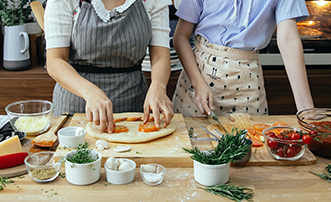November is National Family Caregiver Month – a month to celebrate and appreciate all that caregivers do! Nutrition is one piece of the puzzle a caregiver must put together. Providing well-balanced, nutritious meals is key in protecting against chronic diseases. Although there are many challenges, such as loved ones having reduced appetite and issues with swallowing or chewing, it’s important to accommodate to the needs of the one being cared for to prevent things like malnutrition, chronic disease, and hospitalizations.
Prepare Healthy Meals
Nutritious and well-balanced meals are important to be sure your loved one is receiving enough protein, vitamins, minerals, etc. to promote healthy aging. Be sure to include plenty of protein options to preserve bone and muscle mass. Fruit and vegetables should be offered at every meal as they are packed with vitamins and minerals to help lower the risk of chronic disease such as heart disease, stroke, and cancer. Whole grains are important as they provide protein, fiber, vitamins, and minerals.
Try to avoid too many foods items that contain saturated or trans fats such as deep fried items (doughnuts and French fries) or bakery items (cakes and cookies). Also try to avoid foods high in sodium such as lunch meats and processed foods. Too much sodium can cause the body to retain fluid which, over time, could lead to a greater risk of heart disease, stroke, and kidney disease.
Healthy On-Hand Options
Be sure to have ready-to-eat food options that are healthy and appealing. It’s easy to grab chips and cookies when they are available, but they are not a nutritious option. Here are some snack ideas that are healthier to have on-hand:
• Washed and ready to eat fruits such as grapes, melons, berries, and citrus
• Trail mix with dried fruits and different types of nuts
• Yogurt
• Hard boiled eggs
• Popcorn
• Premade smoothies or protein shakes
Cook Together
Preparing the meal with your loved one may help them become more interested in eating because they helped to prepare it and hopefully it’s something they will enjoy! Additionally, they will know what ingredients were used if they have any food aversions. This time together also gives you the opportunity to have a conversation about the meal. A positive conversation can help your loved one have an interest in eating the meal.
Eat Together
Eating together may seem like a simple thing, but it has a great impact on your loved one. If they see you eating, they are more likely to want to eat as well. Mealtime is also a great opportunity for conversation! When the environment is quiet and welcoming, it will lend itself to conversation. It has been shown that conversation over mealtime promotes connectedness and a sense of belonging, so be sure to turn off the TV and radio, put away your phone, and focus on the conversation.
Overall, fitting the pieces to the caregiving puzzle together can be difficult and overwhelming, but this month especially, celebrate what it takes to be a wonderful caregiver! Try out some of these tips to help ease mealtime stress.
Source: caregivercalifornia.org




